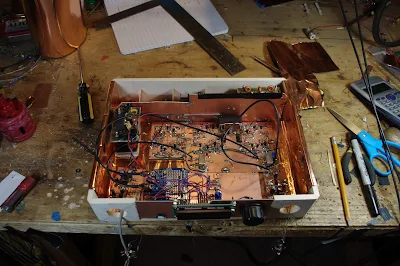Basic Basswood Box (From Michael's or Amazon)
Space cut out for Si5351 board and for AF Gain and Mic jack
Copper flashing placed (from Home Depot)
Amplifier Chain placed along the back
Note Plug-In Low Pass Filter
Starting to look Rig-ish
The View from Above
Still to do:
Socketry along the back (Antenna, 12V, external amp T/R control, Speaker, MAYBE: IF connection).
Relay wiring (I'm trying to do this with just 2 DPDT relays: one for Low Pass Filter switching and External Amp T/R control, and one for 12V T/R switching, and Bandpass Filter switching.
Our book: "SolderSmoke -- Global Adventures in Wireless Electronics"
http://soldersmoke.com/book.htm
Our coffee mugs, T-Shirts, bumper stickers:
http://www.cafepress.com/SolderSmoke
Our Book Store:
http://astore.amazon.com/contracross-20
















